fuel pressure FIAT IDEA 2010 1.G Owners Manual
[x] Cancel search | Manufacturer: FIAT, Model Year: 2010, Model line: IDEA, Model: FIAT IDEA 2010 1.GPages: 210, PDF Size: 4.4 MB
Page 92 of 210
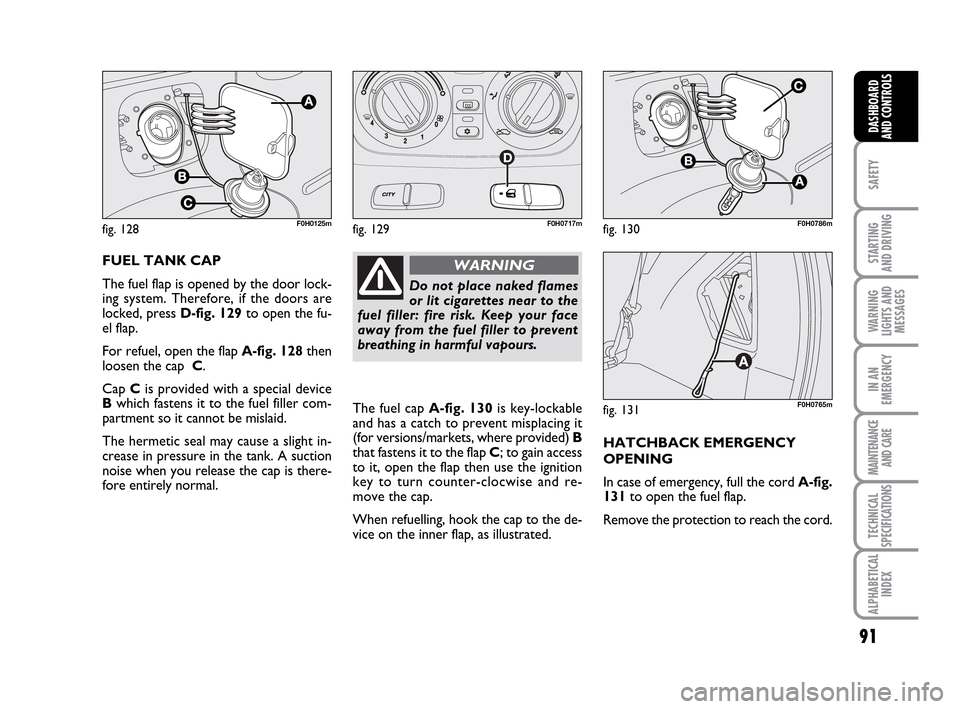
91
SAFETY
STARTING
AND DRIVING
WARNING
LIGHTS AND
MESSAGES
IN AN
EMERGENCY
MAINTENANCE
AND CARE
TECHNICAL
SPECIFICATIONS
ALPHABETICAL
INDEX
DASHBOARD
AND CONTROLS
FUEL TANK CAP
The fuel flap is opened by the door lock-
ing system. Therefore, if the doors are
locked, press D-fig. 129to open the fu-
el flap.
For refuel, open the flap A-fig. 128then
loosen the cap C.
Cap Cis provided with a special device
Bwhich fastens it to the fuel filler com-
partment so it cannot be mislaid.
The hermetic seal may cause a slight in-
crease in pressure in the tank. A suction
noise when you release the cap is there-
fore entirely normal.
fig. 128F0H0125m
HATCHBACK EMERGENCY
OPENING
In case of emergency, full the cord A-fig.
131to open the fuel flap.
Remove the protection to reach the cord.
fig. 131F0H0765m
fig. 129F0H0717m
Do not place naked flames
or lit cigarettes near to the
fuel filler: fire risk. Keep your face
away from the fuel filler to prevent
breathing in harmful vapours.
WARNING
fig. 130F0H0786m
The fuel cap A-fig. 130is key-lockable
and has a catch to prevent misplacing it
(for versions/markets, where provided) B
that fastens it to the flap C; to gain access
to it, open the flap then use the ignition
key to turn counter-clocwise and re-
move the cap.
When refuelling, hook the cap to the de-
vice on the inner flap, as illustrated.
036-092 LUM IDEA GB 2 ed.qxd 14-01-2010 12:15 Pagina 91
Page 117 of 210
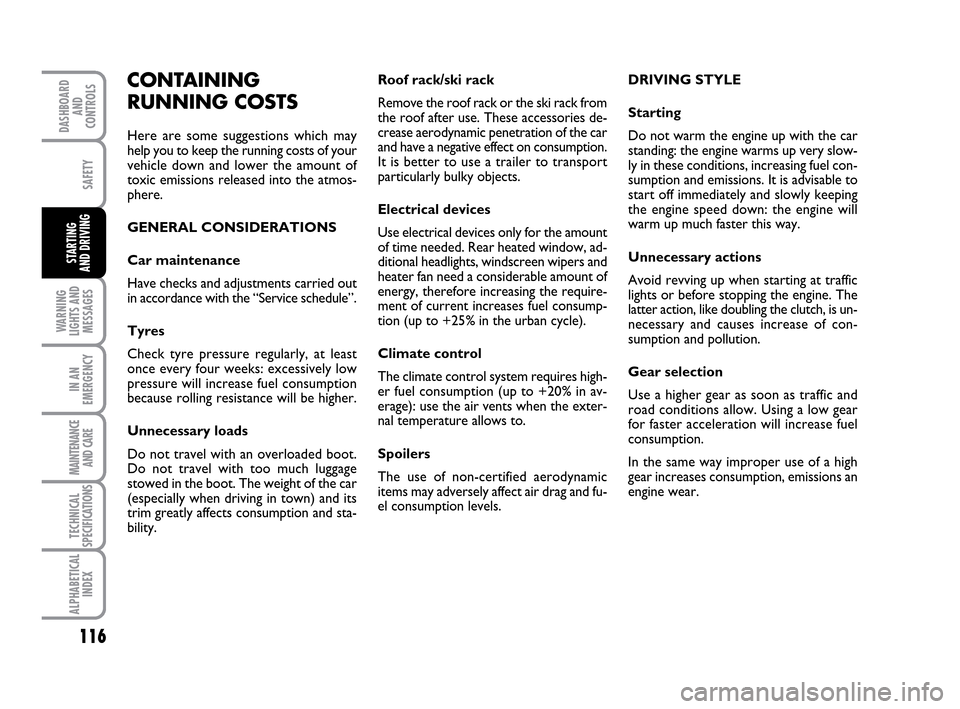
116
WARNING
LIGHTS AND
MESSAGES
IN AN
EMERGENCY
MAINTENANCE
AND CARE
TECHNICAL
SPECIFICATIONS
ALPHABETICAL
INDEX
DASHBOARD
AND
CONTROLS
SAFETY
STARTING
AND DRIVING
CONTAINING
RUNNING COSTS
Here are some suggestions which may
help you to keep the running costs of your
vehicle down and lower the amount of
toxic emissions released into the atmos-
phere.
GENERAL CONSIDERATIONS
Car maintenance
Have checks and adjustments carried out
in accordance with the “Service schedule”.
Tyres
Check tyre pressure regularly, at least
once every four weeks: excessively low
pressure will increase fuel consumption
because rolling resistance will be higher.
Unnecessary loads
Do not travel with an overloaded boot.
Do not travel with too much luggage
stowed in the boot. The weight of the car
(especially when driving in town) and its
trim greatly affects consumption and sta-
bility.Roof rack/ski rack
Remove the roof rack or the ski rack from
the roof after use. These accessories de-
crease aerodynamic penetration of the car
and have a negative effect on consumption.
It is better to use a trailer to transport
particularly bulky objects.
Electrical devices
Use electrical devices only for the amount
of time needed. Rear heated window, ad-
ditional headlights, windscreen wipers and
heater fan need a considerable amount of
energy, therefore increasing the require-
ment of current increases fuel consump-
tion (up to +25% in the urban cycle).
Climate control
The climate control system requires high-
er fuel consumption (up to +20% in av-
erage): use the air vents when the exter-
nal temperature allows to.
Spoilers
The use of non-certified aerodynamic
items may adversely affect air drag and fu-
el consumption levels.DRIVING STYLE
Starting
Do not warm the engine up with the car
standing: the engine warms up very slow-
ly in these conditions, increasing fuel con-
sumption and emissions. It is advisable to
start off immediately and slowly keeping
the engine speed down: the engine will
warm up much faster this way.
Unnecessary actions
Avoid revving up when starting at traffic
lights or before stopping the engine. The
latter action, like doubling the clutch, is un-
necessary and causes increase of con-
sumption and pollution.
Gear selection
Use a higher gear as soon as traffic and
road conditions allow. Using a low gear
for faster acceleration will increase fuel
consumption.
In the same way improper use of a high
gear increases consumption, emissions an
engine wear.
111-122 LUM IDEA GB 2 ed.qxd 14-01-2010 12:32 Pagina 116
Page 124 of 210
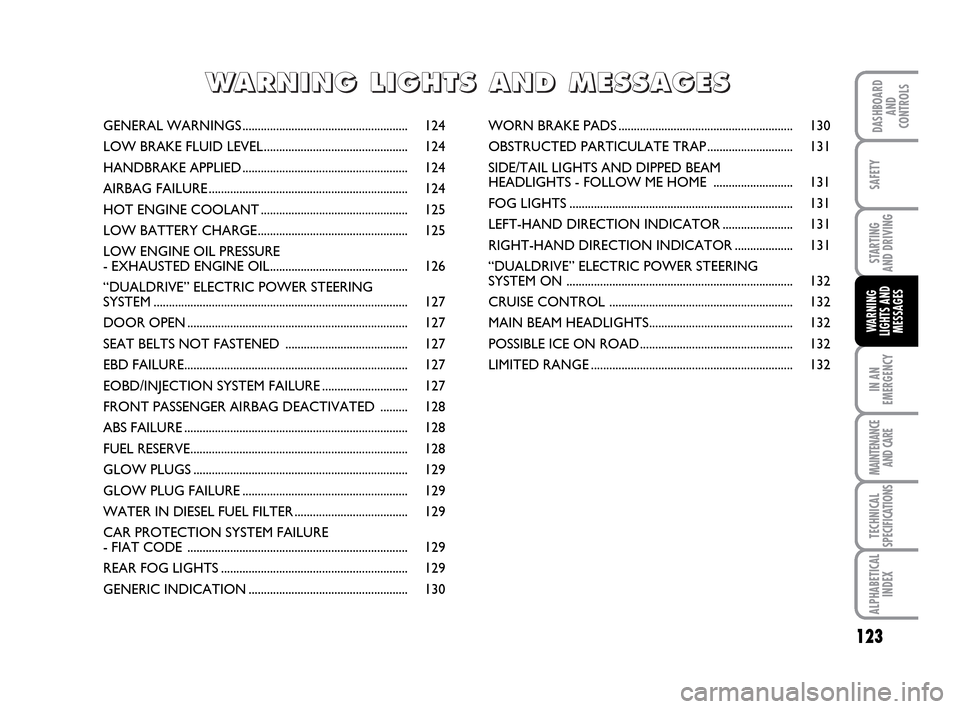
123
STARTING
AND DRIVING
IN AN
EMERGENCY
MAINTENANCE
AND CARE
TECHNICAL
SPECIFICATIONS
ALPHABETICAL
INDEX
DASHBOARD
AND
CONTROLS
SAFETY
WARNING
LIGHTS AND
MESSAGES
GENERAL WARNINGS ...................................................... 124
LOW BRAKE FLUID LEVEL ............................................... 124
HANDBRAKE APPLIED ...................................................... 124
AIRBAG FAILURE ................................................................. 124
HOT ENGINE COOLANT ................................................ 125
LOW BATTERY CHARGE................................................. 125
LOW ENGINE OIL PRESSURE
- EXHAUSTED ENGINE OIL............................................. 126
“DUALDRIVE” ELECTRIC POWER STEERING
SYSTEM ................................................................................... 127
DOOR OPEN ........................................................................ 127
SEAT BELTS NOT FASTENED ........................................ 127
EBD FAILURE......................................................................... 127
EOBD/INJECTION SYSTEM FAILURE ............................ 127
FRONT PASSENGER AIRBAG DEACTIVATED ......... 128
ABS FAILURE ......................................................................... 128
FUEL RESERVE....................................................................... 128
GLOW PLUGS ...................................................................... 129
GLOW PLUG FAILURE ...................................................... 129
WATER IN DIESEL FUEL FILTER ..................................... 129
CAR PROTECTION SYSTEM FAILURE
- FIAT CODE ........................................................................ 129
REAR FOG LIGHTS ............................................................. 129
GENERIC INDICATION .................................................... 130
W W
A A
R R
N N
I I
N N
G G
L L
I I
G G
H H
T T
S S
A A
N N
D D
M M
E E
S S
S S
A A
G G
E E
S S
WORN BRAKE PADS ......................................................... 130
OBSTRUCTED PARTICULATE TRAP ............................ 131
SIDE/TAIL LIGHTS AND DIPPED BEAM
HEADLIGHTS - FOLLOW ME HOME .......................... 131
FOG LIGHTS ......................................................................... 131
LEFT-HAND DIRECTION INDICATOR ....................... 131
RIGHT-HAND DIRECTION INDICATOR ................... 131
“DUALDRIVE” ELECTRIC POWER STEERING
SYSTEM ON .......................................................................... 132
CRUISE CONTROL ............................................................ 132
MAIN BEAM HEADLIGHTS............................................... 132
POSSIBLE ICE ON ROAD.................................................. 132
LIMITED RANGE .................................................................. 132
123-132 LUM IDEA GB 2 ed.qxd 14-01-2010 13:47 Pagina 123
Page 131 of 210
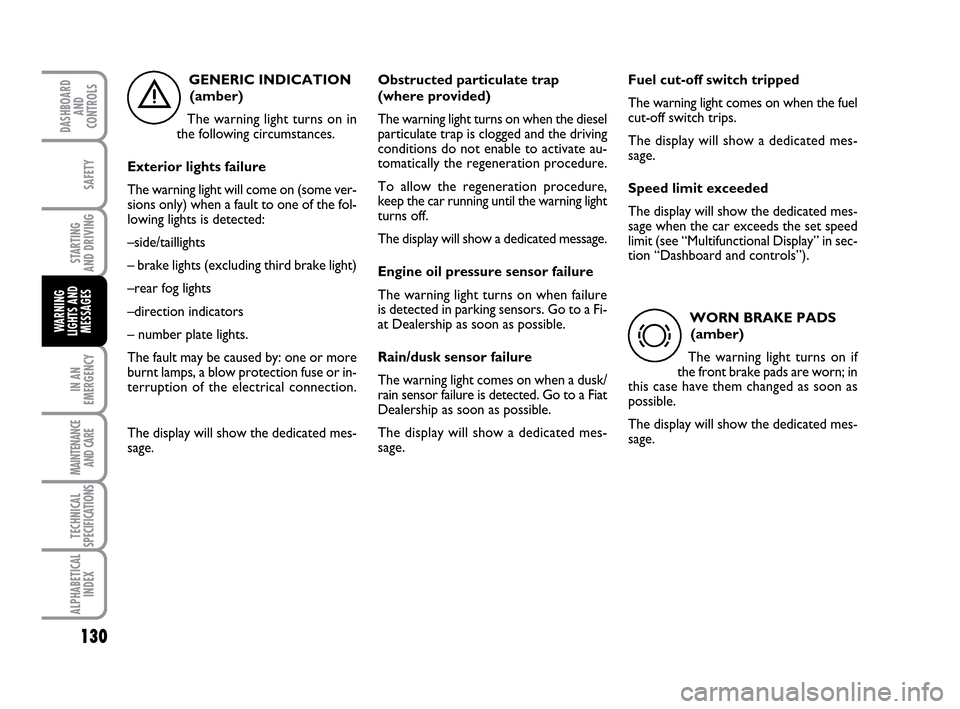
130
STARTING
AND DRIVING
IN AN
EMERGENCY
MAINTENANCE
AND CARE
TECHNICAL
SPECIFICATIONS
ALPHABETICAL
INDEX
DASHBOARD
AND
CONTROLS
SAFETY
WARNING
LIGHTS AND
MESSAGES
GENERIC INDICATION
(amber)
The warning light turns on in
the following circumstances.
Exterior lights failure
The warning light will come on (some ver-
sions only) when a fault to one of the fol-
lowing lights is detected:
–side/taillights
– brake lights (excluding third brake light)
–rear fog lights
–direction indicators
– number plate lights.
The fault may be caused by: one or more
burnt lamps, a blow protection fuse or in-
terruption of the electrical connection.
The display will show the dedicated mes-
sage.
è
Obstructed particulate trap
(where provided)
The warning light turns on when the diesel
particulate trap is clogged and the driving
conditions do not enable to activate au-
tomatically the regeneration procedure.
To allow the regeneration procedure,
keep the car running until the warning light
turns off.
The display will show a dedicated message.
Engine oil pressure sensor failure
The warning light turns on when failure
is detected in parking sensors. Go to a Fi-
at Dealership as soon as possible.
Rain/dusk sensor failure
The warning light comes on when a dusk/
rain sensor failure is detected. Go to a Fiat
Dealership as soon as possible.
The display will show a dedicated mes-
sage.Fuel cut-off switch tripped
The warning light comes on when the fuel
cut-off switch trips.
The display will show a dedicated mes-
sage.
Speed limit exceeded
The display will show the dedicated mes-
sage when the car exceeds the set speed
limit (see “Multifunctional Display” in sec-
tion “Dashboard and controls”).
WORN BRAKE PADS
(amber)
The warning light turns on if
the front brake pads are worn; in
this case have them changed as soon as
possible.
The display will show the dedicated mes-
sage.
d
123-132 LUM IDEA GB 2 ed.qxd 14-01-2010 13:47 Pagina 130
Page 164 of 210

163
STARTING
AND DRIVING
IN AN
EMERGENCY
TECHNICAL
SPECIFICATIONS
ALPHABETICAL
INDEX
DASHBOARD
AND
CONTROLS
SAFETY
WARNING
LIGHTS AND
MESSAGES
MAINTENANCE
AND CARE
20 40 60 80 100 120 140 160 180
●●●●● ●●●●
●●●●● ●●●●
●●●●● ●●●●
●●●●● ●●●●
●●●
●● ● ●
●●●●● ●●●●
●●●●● ●●●●
●●
●●
●●●
SERVICE SCHEDULE
Thousands of kilometres
Check tyre condition/wear and, if necessary,
adjust pressure
Check lighting system operation
(headlights, direction indicators, hazard lights, boot, passenger
compartment, oddment compartments, instrument panel warning
lights, etc.)
Check windscreen wiper/washer
(nozzle direction and blade wear)
Check conditions and wear of front disk brake pads and
operation of pad wear indicator
Check rear drum brake linings
and wear
Check condition and wear of rear brake discs
(where provided)
Visually inspect the condition of: exterior bodywork, underbody
protection, flexible and stiff piping (exhaust, fuel
feed, brakes), rubber parts (boots, sleeves, bushings, etc.)
Check cleanness of locks, bonnet and boot and lever
cleanness and lubrication
Check tension and conditions of various accessory drive belts
except for engines with automatic take-up devices)
Inspect conditions of various drive belts
Check and adjust tappets
(1.48Vversions)
161-180 LUM IDEA GB 2 ed.qxd 14-01-2010 13:52 Pagina 163
Page 166 of 210
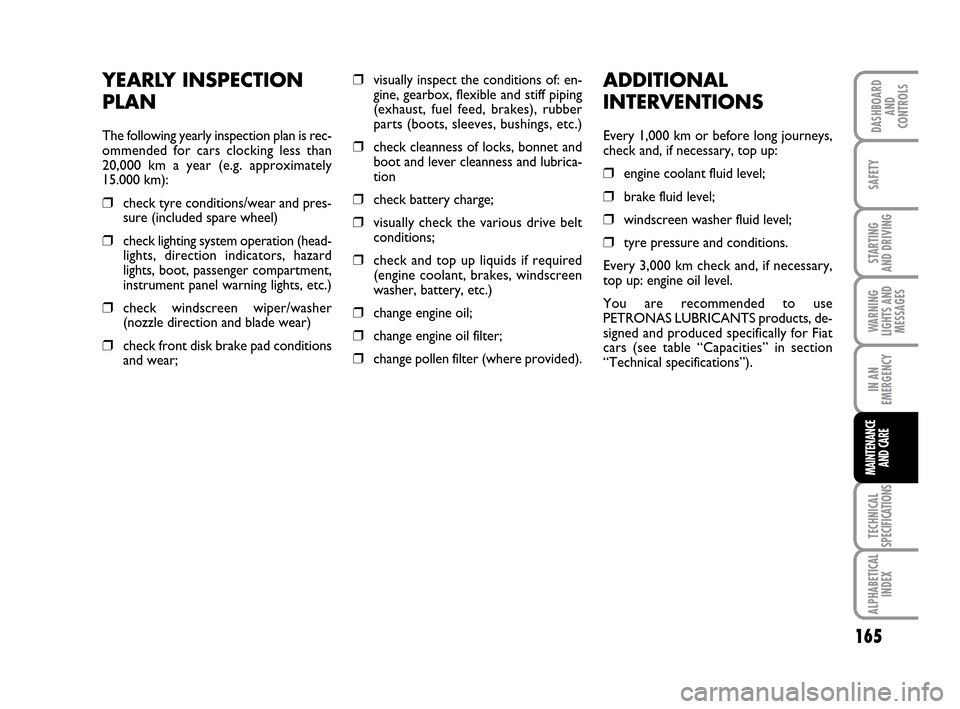
165
STARTING
AND DRIVING
IN AN
EMERGENCY
TECHNICAL
SPECIFICATIONS
ALPHABETICAL
INDEX
DASHBOARD
AND
CONTROLS
SAFETY
WARNING
LIGHTS AND
MESSAGES
MAINTENANCE
AND CARE
YEARLY INSPECTION
PLAN
The following yearly inspection plan is rec-
ommended for cars clocking less than
20,000 km a year (e.g. approximately
15.000 km):
❒check tyre conditions/wear and pres-
sure (included spare wheel)
❒check lighting system operation (head-
lights, direction indicators, hazard
lights, boot, passenger compartment,
instrument panel warning lights, etc.)
❒check windscreen wiper/washer
(nozzle direction and blade wear)
❒check front disk brake pad conditions
and wear;
❒visually inspect the conditions of: en-
gine, gearbox, flexible and stiff piping
(exhaust, fuel feed, brakes), rubber
parts (boots, sleeves, bushings, etc.)
❒check cleanness of locks, bonnet and
boot and lever cleanness and lubrica-
tion
❒check battery charge;
❒visually check the various drive belt
conditions;
❒check and top up liquids if required
(engine coolant, brakes, windscreen
washer, battery, etc.)
❒change engine oil;
❒change engine oil filter;
❒change pollen filter (where provided).
ADDITIONAL
INTERVENTIONS
Every 1,000 km or before long journeys,
check and, if necessary, top up:
❒engine coolant fluid level;
❒brake fluid level;
❒windscreen washer fluid level;
❒tyre pressure and conditions.
Every 3,000 km check and, if necessary,
top up: engine oil level.
You are recommended to use
PETRONAS LUBRICANTS products, de-
signed and produced specifically for Fiat
cars (see table “Capacities” in section
“Technical specifications”).
161-180 LUM IDEA GB 2 ed.qxd 14-01-2010 13:52 Pagina 165
Page 209 of 210
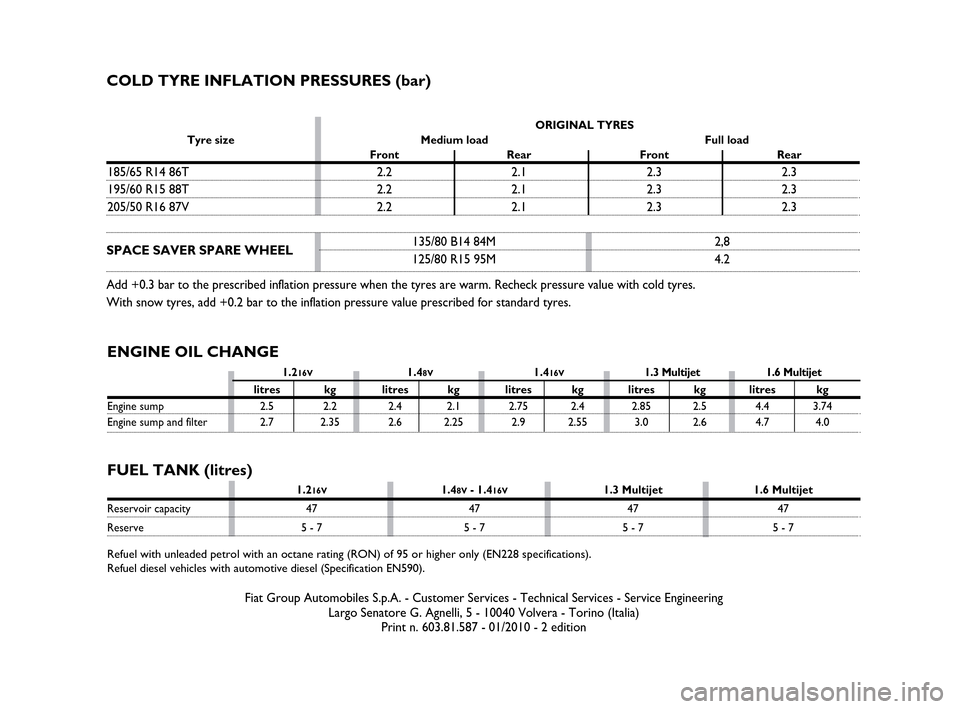
FUEL TANK (litres)
ENGINE OIL CHANGE
Fiat Group Automobiles S.p.A. - Customer Services - Technical Services - Service Engineering
Largo Senatore G. Agnelli, 5 - 10040 Volvera - Torino (Italia)
Print n. 603.81.587 - 01/2010 - 2 edition
COLD TYRE INFLATION PRESSURES (bar)
1.216V1.48V- 1.416V1.3 Multijet 1.6 Multijet
Reservoir capacity 47 47 47 47
Reserve 5 - 7 5 - 7 5 - 7 5 - 7
Refuel with unleaded petrol with an octane rating (RON) of 95 or higher only (EN228 specifications).
Refuel diesel vehicles with automotive diesel (Specification EN590).
1.216V1.48V1.416V1.3 Multijet 1.6 Multijet
litres kg litres kg litres kg litres kg litres kg
Engine sump 2.5 2.2 2.4 2.1 2.75 2.4 2.85 2.5 4.4 3.74
Engine sump and filter 2.7 2.35 2.6 2.25 2.9 2.55 3.0 2.6 4.7 4.0ORIGINAL TYRES
Tyre size Medium load Full load
Front Rear Front Rear
185/65 R14 86T 2.2 2.1 2.3 2.3
195/60 R15 88T 2.2 2.1 2.3 2.3
205/50 R16 87V 2.2 2.1 2.3 2.3
SPACE SAVER SPARE WHEEL135/80 B14 84M 2,8125/80 R15 95M 4.2
Add +0.3 bar to the prescribed inflation pressure when the tyres are warm. Recheck pressure value with cold tyres.
With snow tyres, add +0.2 bar to the inflation pressure value prescribed for standard tyres.
200-208 LUM IDEA GB 2 ed.qxd 14-01-2010 13:59 Pagina 208